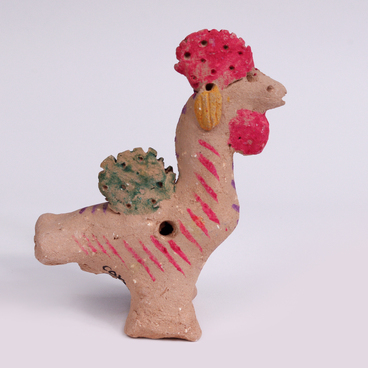The Kozhlya clay toy appeared in the village of Kozhlya, Kursk Oblast. It is difficult to say when the village was founded, but in 1785, the records mentioned the settlement under two names: Nikolaevskaya Sloboda and ‘Kozlya tozh’. The records tell that in the late 18th century this land was bought by the landowner Denisiev, who brought his serfs there from the Poltava Governorate, Ukraine. There is a version that the Ukrainian settlers gave the village its second name. The researcher Tatiana Skoblikova wrote that ‘Kozlya’ means ‘goat’ in Ukrainian, and at that time, there were many goats in that area. Later, the letter ‘z’ was changed to ‘zh’ and the spelling stayed like this.
Some sources indicate that the time of Denisiev’s purchase can be considered the village’s birth date. But Tatyana Skoblikova believed that Kozhlya, most likely, had been inhabited earlier.
There were equal numbers of Russians and Ukrainians in the village, so a special spoken language developed that combined Russian and Ukrainian. For example, meadow strawberries were called ‘polunytsa’, and the place where clay was found in Kozhlya was called ‘glynishche’. When making the Kozhlya toy, craftswomen also used unusual expressions in the process of their work, like ‘raspleskovyvat’ meant ‘to flatten’, the word ‘splyusyvat’’ meant “to squeeze”. They called a lump of clay “grudka”.
Olga Deriglazova is a native of Kozhlya village, descended from a family of craftswomen. She created this horseman toy and maintained the craft traditions.
Kozhlya horsemen are usually whistles. The whistle chamber is inside the horse’s body. It is molded according to a certain technology: a clay ball is flattened into a flat ‘pancake’, then the craftswoman stretches it and makes a ‘cup’ and then joins its edges, leaving a cavity inside. This base is used to make a whistle with a mouthpiece — the part into which you need to blow in order to extract sound. In Kozhlya, this detail was called ‘zhupka’. Then the craftswomen added all the other parts using extra lumps of clay and attaching them to the base.
Olga Deriglazova usually made the horse’s neck in her own way: she stretched it upwards, and then bent it to make a snout. The craftswoman pushed the mane through with her fingers, and formed the ears from two more small lumps. She sculpted the horseman separately, smoothing the neck and waist along their contours with her thumb. The craftswoman created the faces of the horsemen by lightly pressing down the clay. The nose was made in the form of a thin “sausage”. Then she marked the eyes with the sharp end of the stick, and the mouth — with the flat end of the instrument.
Even in ancient times, clay toys were made and painted strictly according to the rules. They were created not only for fun, but also as part of ancient rituals. It was believed that they protected families from evil spirits, called upon the good gods to send a large harvest, and protected them from misfortune. Toys were given to each other as holiday gifts and put on display at home.
Some sources indicate that the time of Denisiev’s purchase can be considered the village’s birth date. But Tatyana Skoblikova believed that Kozhlya, most likely, had been inhabited earlier.
There were equal numbers of Russians and Ukrainians in the village, so a special spoken language developed that combined Russian and Ukrainian. For example, meadow strawberries were called ‘polunytsa’, and the place where clay was found in Kozhlya was called ‘glynishche’. When making the Kozhlya toy, craftswomen also used unusual expressions in the process of their work, like ‘raspleskovyvat’ meant ‘to flatten’, the word ‘splyusyvat’’ meant “to squeeze”. They called a lump of clay “grudka”.
Olga Deriglazova is a native of Kozhlya village, descended from a family of craftswomen. She created this horseman toy and maintained the craft traditions.
Kozhlya horsemen are usually whistles. The whistle chamber is inside the horse’s body. It is molded according to a certain technology: a clay ball is flattened into a flat ‘pancake’, then the craftswoman stretches it and makes a ‘cup’ and then joins its edges, leaving a cavity inside. This base is used to make a whistle with a mouthpiece — the part into which you need to blow in order to extract sound. In Kozhlya, this detail was called ‘zhupka’. Then the craftswomen added all the other parts using extra lumps of clay and attaching them to the base.
Olga Deriglazova usually made the horse’s neck in her own way: she stretched it upwards, and then bent it to make a snout. The craftswoman pushed the mane through with her fingers, and formed the ears from two more small lumps. She sculpted the horseman separately, smoothing the neck and waist along their contours with her thumb. The craftswoman created the faces of the horsemen by lightly pressing down the clay. The nose was made in the form of a thin “sausage”. Then she marked the eyes with the sharp end of the stick, and the mouth — with the flat end of the instrument.
Even in ancient times, clay toys were made and painted strictly according to the rules. They were created not only for fun, but also as part of ancient rituals. It was believed that they protected families from evil spirits, called upon the good gods to send a large harvest, and protected them from misfortune. Toys were given to each other as holiday gifts and put on display at home.



